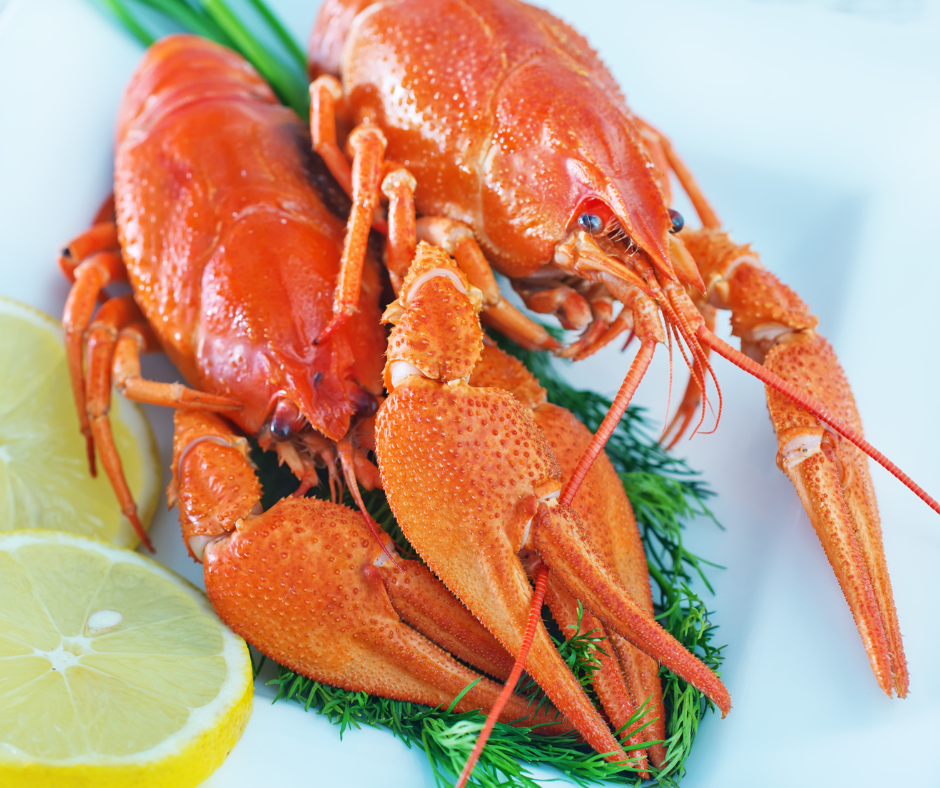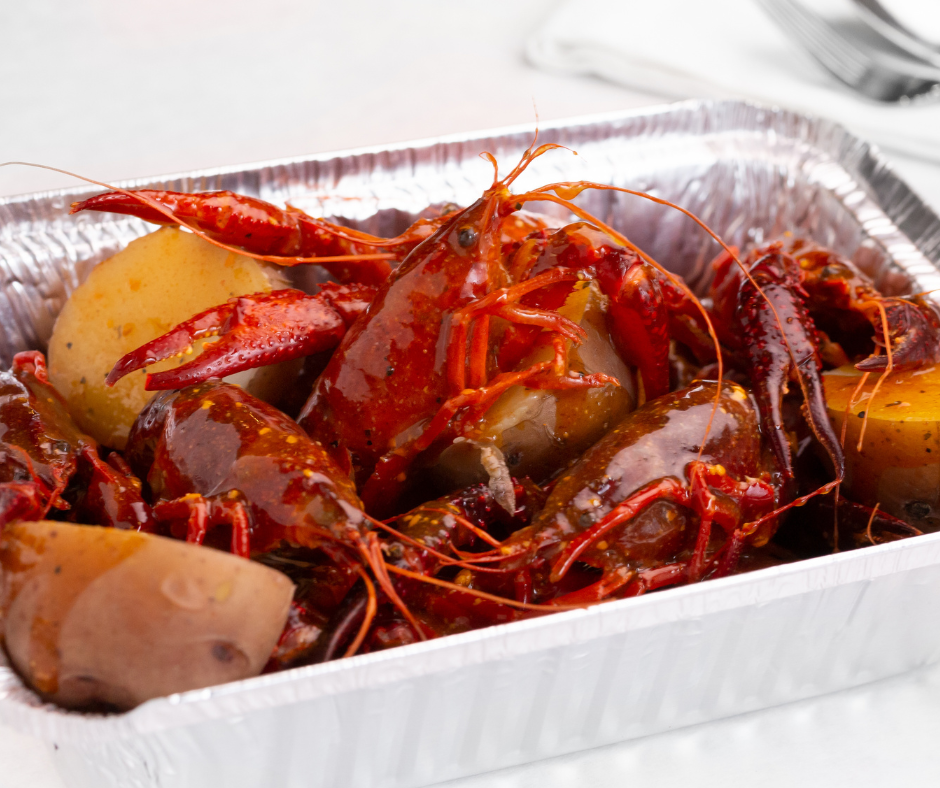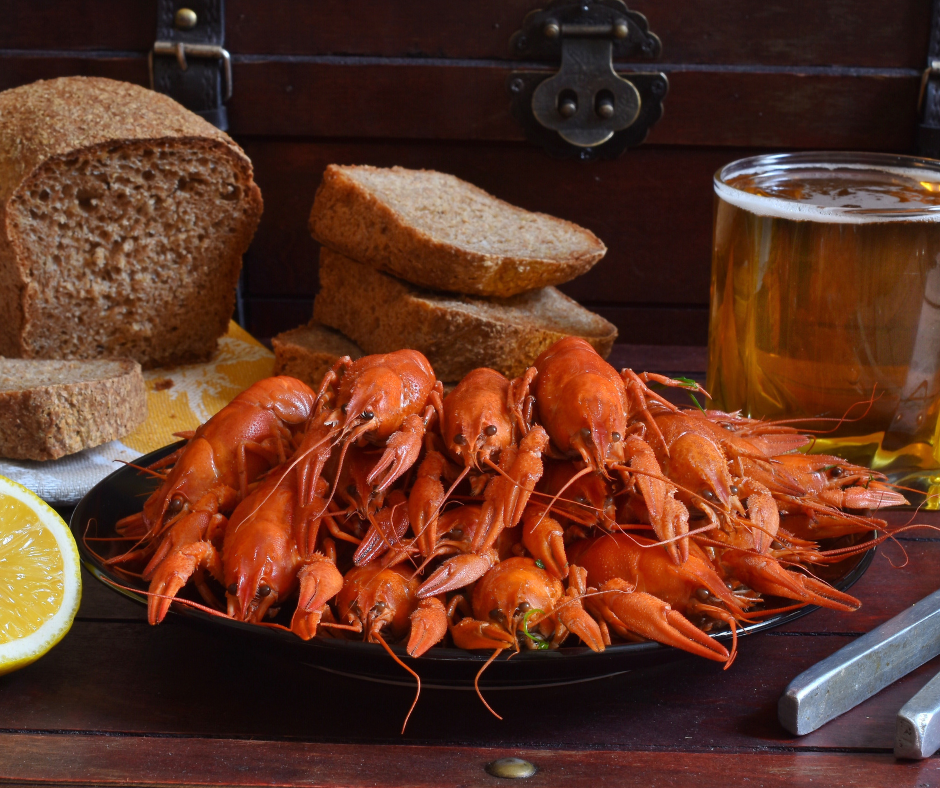Introduction
Crawfish, also known as crayfish or crawdads, are small freshwater crustaceans that resemble mini-lobsters. These small creatures are three to six inches long and have a hard protective exoskeleton. Like lobsters and crabs, they are known for their front two large claws.
If you’ve never tried crawfish, you’re in for a tasty treat. Before diving into the world of Louisiana dishes that contain crawfish, you should know a little bit about this small creature of the sea. This blog will help you explore ‘What Is a Crawfish?‘.
What Is a Crawfish? A Brief Overview
Crawfish are freshwater crustaceans, usually ranging in length from three to six inches. They have a hard protective exoskeleton and 10 walking legs, with the front two as larger claws – like lobsters and crabs.
These small creatures are scavengers, feeding on small aquatic plants and animals. They are often found in ponds, streams, and other bodies of water with muddy bottoms.
When it comes to flavor, crawfish has sweet and tender meat. The taste is often compared to lobster but has a slightly milder flavor. Crawfish is a popular ingredient in Cajun and Creole cuisine, and there are countless recipes for crawfish boils, étouffées, and jambalayas.
If you want to try crawfish, you can find them fresh or frozen in many specialty seafood markets. You can order them online and have them shipped directly to your doorstep.
In conclusion, crawfish is a tasty and unique ingredient in southern cuisine. Whether you are a seasoned crawfish lover or a newcomer to this small freshwater crustacean, understanding its flavor and texture can lead to delicious culinary experiences.
The Anatomy Of A Crawfish
Crawfish, crayfish, or crawdads are interesting creatures with unique anatomy. Understanding their anatomy can give insight into their behavior and even help prepare them for cooking.
The Cephalothorax And Abdomen
A crawfish comprises two main parts: the cephalothorax and the abdomen. The cephalothorax is the front part of the crawfish and is covered by a hard exoskeleton to protect the internal organs. The abdomen is the back part of the crawfish and contains the digestive organs and reproductive system.
The cephalothorax contains the eyes, antennae, and mouthparts. The eyes are situated on stalks and can move independently to scan the surroundings. The antennae are sensory organs that detect food, predators, and other stimuli. The mouthparts consist of mandibles, maxillae, and maxillipeds, used to crush and shred food.
The Claws And Legs
The most distinctive feature of a crawfish is its large claws, which are the first two pairs of legs. These claws are used for defense, capturing prey, and even mating rituals. The claws have small pincers that allow the crawfish to manipulate small objects.
The other eight legs of a crawfish are used for walking and are jointed for flexibility. The legs have small hooks that help the crawfish grip surfaces and move through the water.
In conclusion, understanding the anatomy of a crawfish can give insight into their behavior and even help prepare them for cooking. The cephalothorax contains important sensory organs and mouthparts, while the claws and legs are used for defense and movement.
Understanding Crawfish Habitats
Crawfish are freshwater crustaceans found in various habitats in the wild, such as streams, rivers, swamps, and marshes. Understanding these habitats can help with proper husbandry when keeping crawfish in captivity.
Crawfish Habitats In The Wild
Crawfish are prevalent in North America and Europe and can be found in various freshwater bodies. In streams and rivers, crawfish live in shallow waters with rocky bottoms where they can hide from predators like fish and birds. Crawfish can also be found in swamps and marshes, burrowing into muddy banks to protect themselves from predators and extreme temperatures.
In addition to providing a hiding spot, rocks and vegetation in freshwater habitats also serve as food for crawfish. Crawfish feed on algae, plants, insects, and other small aquatic animals, especially in the warmer months.
Crawfish Habitats In Captivity
Crawfish can also be kept in captivity, but it’s important to mimic their natural habitat as much as possible. To do this, it’s important to provide a similar environment with rocks for hiding and enough space to move around and explore.
Crawfish also require clean, fresh water with proper water chemistry. They prefer a slightly acidic pH and soft water. Overcrowding can lead to aggression and stress, weakening immune systems and disease.
In summary, understanding the habitats of crawfish can provide useful insights into their behavior and needs when kept in captivity. Rocks, vegetation, and clean water are essential for their well-being, and mimicking their natural environment is important for their long-term health.
Crawfish Behavior
Crawfish, or crayfish, are fascinating creatures with unique behavior patterns. Understanding their behavior can help with their proper care and husbandry in captivity.
Crawfish Social Structure
Crawfish are social creatures that live in groups called colonies. In the wild, colonies can range from just a few individuals up to hundreds or even thousands. Within a colony, crawfish establish social hierarchies based on size and dominance. The largest and most dominant crawfish are called “alpha” or “boss” and have priority access to food, shelter, and mates. Crawfish use a variety of displays, including posturing, antenna waving, and snapping when interacting with each other.
In captivity, crawfish should be housed in groups of at least 4-6 individuals to prevent isolation and aggression. Providing ample hiding places and feeding spots can help prevent dominance-related conflicts.
Crawfish Communication
Crawfish communicate with each other using chemical signals and vibrations. They use their urine to send chemical signals to indicate information such as their sex, reproductive status, and social hierarchy. Crawfish also communicate through vibrations, which they can detect using their specialized antennae. These vibrations can convey information about threats or mating opportunities.
In captivity, crawfish can be provided with logs or other objects that can be used as structures to climb on. This can help them communicate through vibration signals and provide a stimulating environment to explore.
In conclusion, understanding crawfish’s social structure and communication behaviors can help with their proper care and husbandry in captivity. Providing ample hiding places, feeding spots, and structures for communication can help prevent conflicts and promote a healthy environment for these fascinating creatures.
The Nutritional Value Of Crawfish
Calorie And Nutritional Content
Crawfish are a low-calorie, low-fat, and high-protein seafood. A 100g serving of crawfish tail meat contains only 77 calories and 0.95g of fat, making it a healthy addition to any diet. In addition, crawfish are a good source of essential nutrients such as vitamins B12 and E, calcium, and iron.
Crawfish Health Benefits
The nutritional content of crawfish provides several health benefits. The high protein content in crawfish helps build and repair muscles, while the low fat content makes it a heart-healthy option. The vitamin B12 in crawfish is important for maintaining healthy nerve cells and DNA, and calcium and iron are essential for healthy bones and blood.
In addition to its nutritional value, crawfish contain antioxidants such as astaxanthin and selenium, which can help reduce inflammation and protect against chronic diseases such as cancer and arthritis.
In conclusion, crawfish is a nutritious and healthy seafood option. Its low-calorie and low-fat content, high protein and essential nutrient content, and antioxidant properties make it a great addition to any balanced diet.
Different Types Of Crawfish
Species Of Crawfish
While there are many different species of crawfish, the most commonly eaten and widely known is the Louisiana crawfish. Other species include the Procambarus clarkii, found in the southern United States and Mexico, and the Procambarus alleni, found in Florida.
Identifying Characteristics Of Different Types Of Crawfish
The Louisiana crawfish is typically brownish-red in color with a hard shell and large claws. These crawfish are usually found in freshwater ponds and ditches throughout the Gulf Coast region of the United States.
The Procambarus clarkii, or red swamp crawfish, is a dark red with long claws and a smoother shell. These crawfish are also found in freshwater ponds and ditches, as well as in rice fields and swamps.
The Procambarus alleni, or Florida blue crawfish, is usually blue with large claws and a hard shell. These crawfish are found in Florida’s freshwater ponds, streams, and rivers.
No matter the type of crawfish, all can be cooked in various ways and are a delicious addition to any meal.
Preparing Crawfish For Consumption
How To Prepare Live Crawfish
Before cooking crawfish, it is important to clean and prepare them properly. The following steps ensure that the crawfish are free of any dirt or debris:
- Wash the crawfish thoroughly with running water, removing any crushed or dead.
- Fill a large pot with enough water to cover the crawfish.
- Add onions, garlic, and celery to add flavor to the boil.
- Bring the water to a rolling boil.
- Add the crawfish to the pot and cook for about 5-7 minutes until they turn bright red and float to the top of the pot.
- Remove the crawfish from the pot and cool slightly before peeling and eating.
How To Prepare Frozen Crawfish
If using frozen crawfish, it is still important to properly prepare them before cooking:
- Thaw the frozen crawfish in the refrigerator overnight.
- Rinse the crawfish in cold water to remove any ice crystals.
- Follow the same cooking instructions as for live crawfish.
In conclusion, whether using live or frozen crawfish, taking the time to prepare and clean them properly will result in a delicious meal. With a little know-how, anyone can enjoy the unique taste of this crustacean delicacy.
Popular Crawfish Recipes
Crawfish Étouffée
Crawfish étouffée is a popular Cajun dish that features crawfish cooked in a flavorful roux-based sauce. To make this classic dish, sauté onions and garlic in butter, then whisk in flour to create a roux. Gradually stir in chicken broth, tomatoes, bell peppers, and celery before adding the cooked crawfish tails. Simmer the mixture until it thickens and the flavors meld together, then serve over a bed of white rice.
Crawfish Boil
A crawfish boil is a fun and festive way to enjoy this delicious crustacean with friends and family. To prepare, boil a large pot of salted water and add traditional Cajun seasonings like cayenne pepper, paprika, and garlic powder. Add red potatoes, corn on the cob, and other desired vegetables to the pot before adding live crawfish. Cook for 5-7 minutes or until the crawfish turn bright red and float to the top of the pot. Serve hot on a table covered in newspaper for easy cleanup.
Conclusion
Now you should know the answer to ‘What Is a Crawfish?’. Crawfish is a beloved and celebrated staple of Louisiana’s food culture. Whether in a rich, creamy étouffée or part of a lively boil, crawfish offers something unique. While it may seem intimidating to cook for some, the process is simple, and the payoff is well worth the effort. Crawfish has brought communities and families together for generations, and its continued popularity proves that it is a treasured symbol of Louisiana’s food culture.
FAQ: What Is a Crawfish: Crawfish 101 – Understanding the Crustacean
Q: What is a crawfish?
A: A crawfish is a freshwater crustacean that looks like a small lobster and usually ranges in length from 3-6 inches.
Q: Where can you find crawfish?
A: Crawfish can be found in freshwater sources such as rivers, streams, lakes, and swamps.
Q: What are some other names for crawfish?
A: Depending on your region and upbringing, crawfish may also be known as crayfish, crawdads, mudbugs, or freshwater lobsters.
Q: How does crawfish taste?
A: Crawfish has a sweet, slightly earthy flavor and a tender, slightly firm texture. It is often described as a cross between shrimp and lobster.
Q: How is crawfish typically prepared?
A: Crawfish is a popular ingredient in Cajun and Creole cuisine, often boiled or fried. It can also be used in soups, stews, and étouffées.
Q: What are some tips for getting the best bite of crawfish?
A: To get the best bite of crawfish, ensure it is fresh and cooked properly. Look for lively crawfish with their tails curled tightly, and avoid those with a strong, fishy smell.



